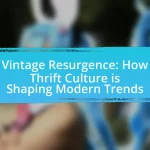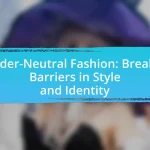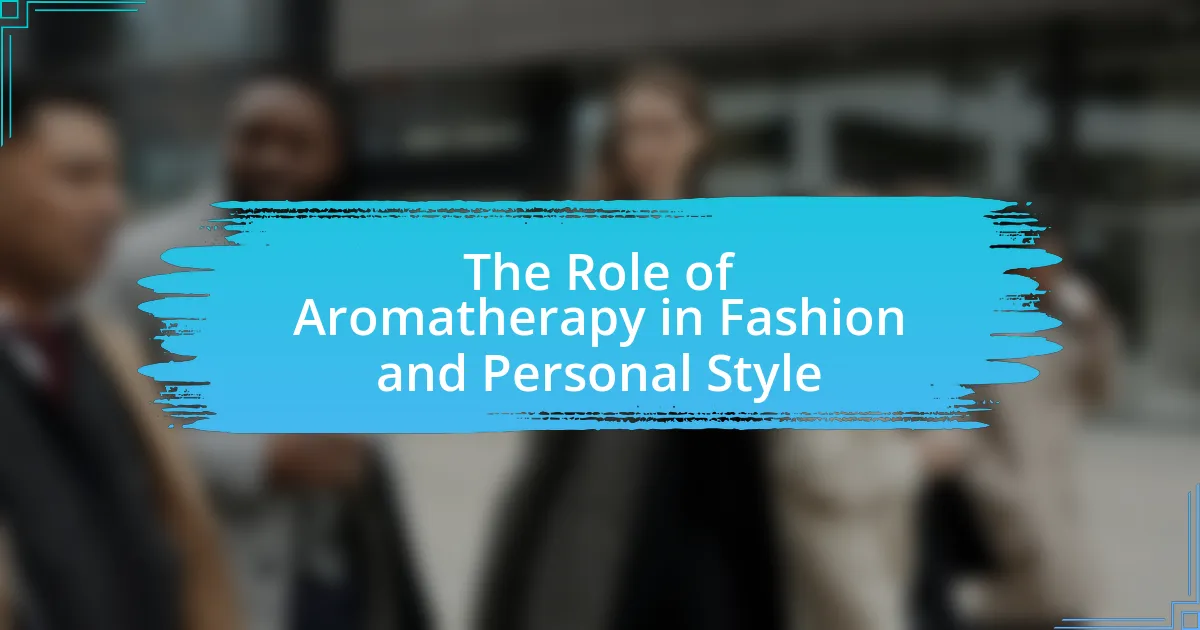The article explores the intersection of fashion and mental wellness, emphasizing how clothing choices influence self-esteem, body image, and emotional well-being. It highlights research findings that demonstrate the psychological effects of clothing, such as increased confidence and improved mood when individuals wear outfits that reflect their personal identity. Additionally, the article addresses the challenges posed by unrealistic beauty standards and fast fashion, which can negatively impact mental health. It also discusses the role of fashion brands in promoting mental wellness through inclusive campaigns and the importance of community support in fostering positive self-image. Overall, the article underscores the significant connection between fashion and mental health, advocating for mindful consumption and self-expression as tools for enhancing well-being.
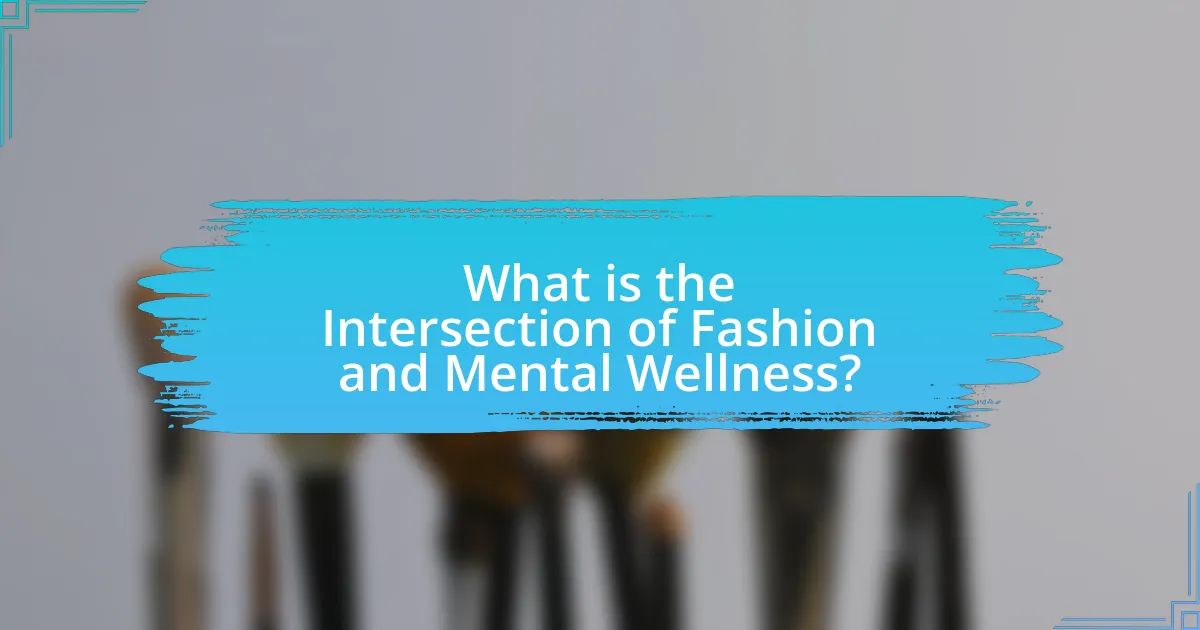
What is the Intersection of Fashion and Mental Wellness?
The intersection of fashion and mental wellness lies in the impact that clothing choices have on an individual’s self-esteem and emotional state. Research indicates that wearing clothes that align with personal identity can enhance mood and promote positive self-image, which is crucial for mental health. For example, a study published in the Journal of Experimental Social Psychology found that participants who wore formal clothing reported higher levels of confidence and abstract thinking compared to those in casual attire. This demonstrates that fashion can serve as a tool for self-expression and empowerment, contributing to overall mental wellness.
How do fashion choices impact mental health?
Fashion choices significantly impact mental health by influencing self-esteem, body image, and social interactions. Wearing clothing that aligns with personal style can enhance confidence and promote a positive self-image, while clothing that feels uncomfortable or does not reflect one’s identity can lead to feelings of inadequacy and anxiety. Research published in the journal “Psychology of Fashion” indicates that individuals who express their identity through fashion report higher levels of self-esteem and overall well-being. Additionally, societal pressures related to fashion trends can contribute to mental health issues, as individuals may feel compelled to conform to unrealistic standards, leading to stress and dissatisfaction.
What psychological effects can clothing have on individuals?
Clothing can significantly influence individuals’ psychological states, affecting their mood, self-esteem, and social interactions. Research indicates that what people wear can alter their cognitive processes and emotional responses; for instance, wearing formal attire has been shown to enhance abstract thinking and increase confidence levels. A study published in the Journal of Experimental Social Psychology found that participants who wore lab coats performed better on attention-related tasks, demonstrating the concept of “enclothed cognition,” where clothing impacts psychological processes. Additionally, clothing can serve as a form of self-expression, allowing individuals to convey their identity and boost their self-image, which can lead to improved mental well-being.
How does personal style influence self-esteem and confidence?
Personal style significantly influences self-esteem and confidence by allowing individuals to express their identity and enhance their self-image. When people feel comfortable and authentic in their clothing choices, they are more likely to project confidence in social situations. Research indicates that wearing clothes that align with one’s personal style can lead to increased feelings of self-worth; for example, a study published in the Journal of Experimental Social Psychology found that participants who dressed in a way that reflected their personal identity reported higher self-esteem and greater confidence in their abilities. This connection between personal style and self-perception underscores the psychological impact of fashion on mental wellness.
Why is mental wellness important in the fashion industry?
Mental wellness is crucial in the fashion industry because it directly impacts creativity, productivity, and overall job satisfaction among professionals. High-pressure environments, unrealistic beauty standards, and constant scrutiny can lead to mental health issues such as anxiety and depression, which negatively affect both individual performance and the industry’s reputation. Research indicates that 72% of fashion professionals experience anxiety related to their work, highlighting the need for mental wellness initiatives to foster a healthier workplace. Prioritizing mental wellness not only enhances employee well-being but also promotes a more sustainable and innovative fashion industry.
How can fashion brands promote mental wellness?
Fashion brands can promote mental wellness by creating inclusive and body-positive campaigns that celebrate diversity and self-acceptance. These initiatives can help reduce stigma around mental health issues and foster a sense of community among consumers. For example, brands like Aerie have successfully implemented campaigns that feature unretouched images of models, which has been shown to improve body image and self-esteem among their audience. Additionally, fashion brands can collaborate with mental health organizations to raise awareness and provide resources, further demonstrating their commitment to mental wellness.
What role does representation play in mental health within fashion?
Representation plays a crucial role in mental health within fashion by influencing self-esteem and body image perceptions. When diverse body types, ethnicities, and gender identities are represented in fashion, it fosters inclusivity and allows individuals to see themselves reflected in the industry. This visibility can reduce feelings of isolation and inadequacy, which are often linked to mental health issues. Research indicates that exposure to diverse representations can lead to improved body satisfaction and lower levels of anxiety and depression among consumers. For instance, a study published in the Journal of Consumer Research found that individuals exposed to models of various sizes reported higher self-esteem and a more positive body image. Thus, representation in fashion not only impacts individual mental health but also contributes to broader societal changes regarding beauty standards.
What are the historical connections between fashion and mental wellness?
Fashion has historically been linked to mental wellness through its influence on self-expression, identity, and societal perceptions. For instance, during the 18th century, clothing styles reflected social status and personal identity, impacting individuals’ self-esteem and mental health. The rise of the suffragette movement in the early 20th century showcased how fashion became a tool for empowerment, allowing women to express their autonomy and challenge societal norms, which positively affected their mental well-being. Additionally, studies have shown that wearing certain types of clothing can enhance mood and confidence, indicating a direct connection between fashion choices and mental health outcomes. For example, research published in the Journal of Experimental Social Psychology found that participants who wore formal clothing performed better on cognitive tasks, suggesting that fashion can influence psychological states.
How has fashion evolved in relation to mental health awareness?
Fashion has evolved significantly to incorporate mental health awareness, reflecting a growing societal recognition of the importance of mental well-being. In recent years, designers and brands have increasingly used their platforms to promote messages of self-acceptance and mental health advocacy, often collaborating with mental health organizations. For instance, the 2021 “Mental Health Awareness Month” campaign by various fashion brands featured clothing lines that included slogans promoting mental health awareness, directly addressing issues like anxiety and depression. This shift is supported by research indicating that fashion can influence self-esteem and body image, which are closely linked to mental health. The integration of mental health themes into fashion not only raises awareness but also fosters a sense of community and support among individuals facing mental health challenges.
What notable movements have linked fashion and mental wellness?
Notable movements linking fashion and mental wellness include the Body Positivity movement and the Mental Health Awareness in Fashion initiative. The Body Positivity movement promotes self-acceptance and challenges traditional beauty standards, encouraging individuals to embrace their bodies regardless of size or shape, which has been shown to improve self-esteem and mental health. The Mental Health Awareness in Fashion initiative, supported by various designers and brands, aims to raise awareness about mental health issues through fashion shows and campaigns, highlighting the importance of mental wellness in the industry. These movements have gained traction, with statistics indicating that 1 in 5 adults experience mental illness, underscoring the relevance of these initiatives in promoting mental wellness through fashion.
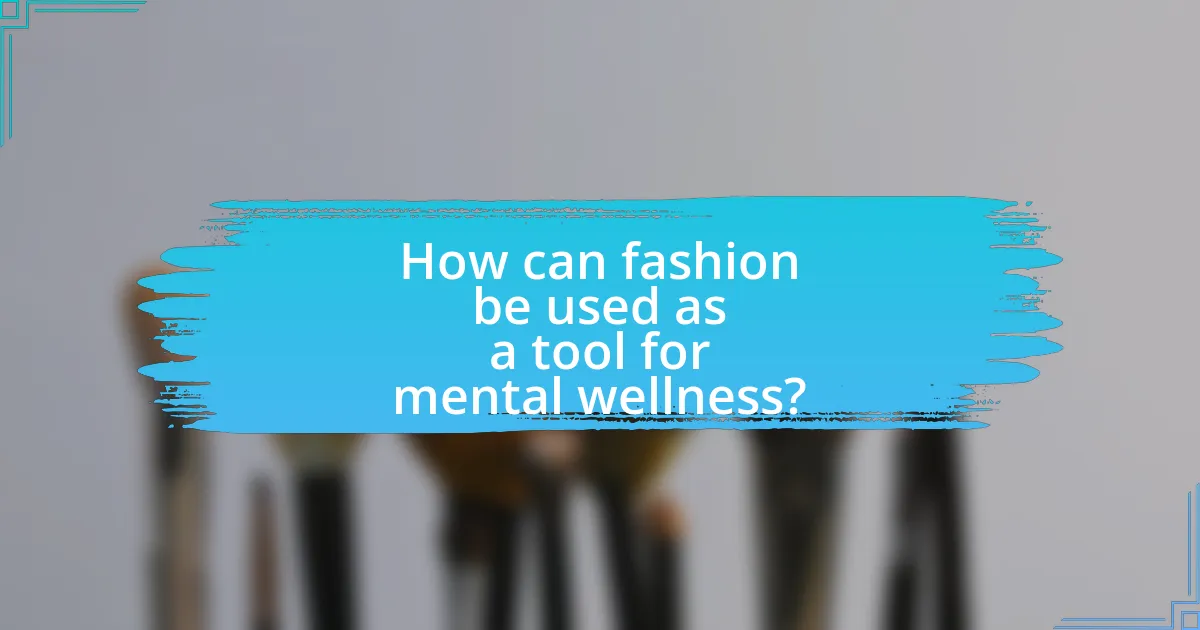
How can fashion be used as a tool for mental wellness?
Fashion can be used as a tool for mental wellness by allowing individuals to express their identity and boost their self-esteem through personal style choices. When people wear clothing that resonates with their personality or mood, it can lead to increased feelings of confidence and happiness. Studies have shown that wearing certain colors or styles can influence emotions; for example, bright colors are often associated with positive feelings, while comfortable clothing can enhance relaxation. Additionally, engaging in fashion-related activities, such as shopping or creating outfits, can serve as a form of self-care, providing a distraction from stress and promoting a sense of control and creativity.
What are the therapeutic benefits of fashion and self-expression?
Fashion and self-expression provide therapeutic benefits by enhancing individual identity and promoting emotional well-being. Engaging in fashion allows individuals to communicate their personality and feelings, which can lead to increased self-esteem and confidence. Research indicates that self-expression through clothing can reduce anxiety and depression, as individuals feel more in control of their image and how they present themselves to the world. A study published in the Journal of Experimental Social Psychology found that wearing clothing that aligns with one’s self-concept can improve mood and increase feelings of authenticity. Thus, the act of choosing and wearing fashion serves as a powerful tool for emotional regulation and personal empowerment.
How does engaging with fashion foster creativity and emotional release?
Engaging with fashion fosters creativity and emotional release by allowing individuals to express their identity and emotions through personal style choices. This form of self-expression can lead to increased creativity as individuals experiment with different looks, colors, and textures, thereby stimulating their imagination. Research indicates that engaging in creative activities, such as fashion design or styling, can enhance mood and reduce stress levels. For instance, a study published in the Journal of Positive Psychology found that creative expression is linked to improved emotional well-being, highlighting how fashion can serve as a therapeutic outlet.
What practices can individuals adopt to use fashion for mental health improvement?
Individuals can adopt practices such as curating a personal wardrobe that reflects their identity, engaging in mindful shopping, and using fashion as a form of self-expression to improve mental health. Curating a wardrobe allows individuals to select clothing that resonates with their personal style, which can enhance self-esteem and promote a positive self-image. Mindful shopping encourages individuals to make intentional choices, reducing impulsive purchases that may lead to buyer’s remorse and stress. Additionally, using fashion as self-expression can foster creativity and provide an outlet for emotions, contributing to overall well-being. Research indicates that dressing in a way that aligns with one’s self-concept can lead to increased confidence and improved mood, supporting the connection between fashion choices and mental health.
How do community and social aspects of fashion contribute to mental wellness?
Community and social aspects of fashion significantly contribute to mental wellness by fostering a sense of belonging and self-expression. Engaging in fashion communities allows individuals to connect with others who share similar interests, which can enhance social support and reduce feelings of isolation. Research indicates that participation in group activities related to fashion, such as fashion shows or collaborative design projects, can lead to increased self-esteem and improved mood. For instance, a study published in the Journal of Fashion Marketing and Management found that individuals who actively engage in fashion-related social activities report higher levels of life satisfaction and emotional well-being. This connection between fashion and community underscores the therapeutic potential of shared interests in promoting mental health.
What role do fashion communities play in supporting mental health?
Fashion communities play a significant role in supporting mental health by providing a sense of belonging and fostering self-expression. These communities create safe spaces where individuals can share their experiences, connect with like-minded people, and receive emotional support. Research indicates that participation in fashion-related groups can enhance self-esteem and reduce feelings of isolation, which are crucial for mental well-being. For instance, a study published in the Journal of Fashion Marketing and Management found that engagement in fashion communities positively correlates with improved mental health outcomes, highlighting the therapeutic benefits of shared interests and collective identity.
How can collaborative fashion initiatives enhance mental wellness?
Collaborative fashion initiatives can enhance mental wellness by fostering community engagement and self-expression. These initiatives often involve collective design processes, workshops, and events that encourage participants to share their stories and creativity, which can lead to improved emotional well-being. Research indicates that social connections and creative activities are linked to reduced feelings of isolation and anxiety. For example, a study published in the Journal of Positive Psychology found that engaging in creative activities can significantly boost mood and overall mental health. By creating inclusive spaces where individuals can collaborate and express themselves, these fashion initiatives contribute positively to mental wellness.
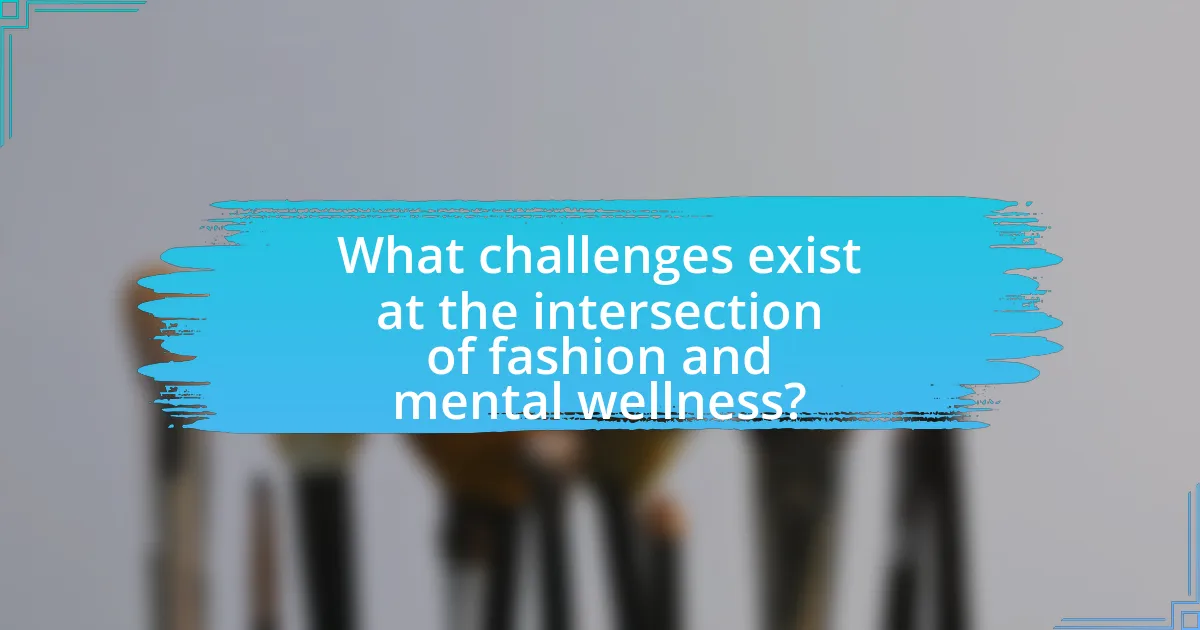
What challenges exist at the intersection of fashion and mental wellness?
Challenges at the intersection of fashion and mental wellness include the pressure to conform to unrealistic beauty standards and the impact of fast fashion on self-esteem. The fashion industry often promotes narrow definitions of beauty, which can lead to body image issues and mental health struggles among individuals. Additionally, the fast fashion model encourages constant consumption and comparison, exacerbating feelings of inadequacy and anxiety. Research indicates that exposure to idealized images in fashion media correlates with increased rates of depression and anxiety, particularly among young people.
What negative impacts can the fashion industry have on mental health?
The fashion industry can negatively impact mental health by promoting unrealistic beauty standards, leading to body dissatisfaction and low self-esteem. Research indicates that exposure to idealized images in fashion media correlates with increased rates of anxiety, depression, and eating disorders among individuals, particularly young women. A study published in the journal “Body Image” found that women who frequently engage with fashion media report higher levels of body dissatisfaction and lower self-esteem, demonstrating a direct link between fashion consumption and mental health issues.
How do unrealistic beauty standards affect mental wellness?
Unrealistic beauty standards negatively impact mental wellness by contributing to body dissatisfaction, low self-esteem, and increased anxiety and depression. Research indicates that exposure to idealized images in media can lead individuals to develop a distorted self-image, often resulting in harmful behaviors such as disordered eating and excessive exercise. A study published in the journal “Body Image” found that women who frequently engage with fashion media report higher levels of body dissatisfaction and lower self-esteem compared to those who do not. Furthermore, the American Psychological Association highlights that these standards can exacerbate mental health issues, particularly among adolescents, leading to a cycle of negative self-perception and mental distress.
What are the consequences of fast fashion on mental health?
Fast fashion negatively impacts mental health by contributing to anxiety, depression, and low self-esteem. The constant pressure to keep up with rapidly changing trends can lead individuals to feel inadequate if they cannot afford or access the latest styles. Research indicates that the overconsumption and waste associated with fast fashion can also create feelings of guilt and stress, as consumers grapple with the environmental consequences of their purchases. A study published in the Journal of Consumer Research found that individuals who frequently engage in fast fashion shopping report higher levels of anxiety and lower life satisfaction compared to those who prioritize sustainable fashion choices.
How can individuals navigate these challenges effectively?
Individuals can navigate the challenges at the intersection of fashion and mental wellness by prioritizing self-expression and authenticity in their clothing choices. Embracing personal style fosters a sense of identity and confidence, which can positively impact mental health. Research indicates that wearing clothes that reflect one’s personality can enhance mood and self-esteem, as noted in a study published in the Journal of Experimental Social Psychology, where participants reported feeling more empowered when dressed in a way that aligned with their self-image. Additionally, individuals can seek support from communities that promote body positivity and mental wellness, creating a network that encourages healthy discussions about fashion’s role in self-perception.
What strategies can be employed to maintain mental wellness while engaging with fashion?
To maintain mental wellness while engaging with fashion, individuals can adopt strategies such as practicing mindful consumption, setting personal style boundaries, and fostering a positive body image. Mindful consumption involves being aware of the emotional impact of fashion choices, which can reduce anxiety related to trends and societal pressures. Setting personal style boundaries helps individuals define their fashion preferences without succumbing to external expectations, promoting self-acceptance. Additionally, fostering a positive body image through self-affirmation and surrounding oneself with supportive communities can enhance mental wellness, as studies show that positive self-perception is linked to improved mental health outcomes.
How can consumers advocate for mental wellness in the fashion industry?
Consumers can advocate for mental wellness in the fashion industry by supporting brands that prioritize mental health initiatives and promoting body positivity. By choosing to purchase from companies that actively engage in mental wellness campaigns, consumers can influence industry standards and practices. For instance, brands like Aerie and Savage X Fenty have successfully integrated body positivity into their marketing, which has been shown to improve self-esteem among consumers. Additionally, consumers can participate in discussions on social media, raising awareness about mental health issues and encouraging brands to adopt more inclusive practices. This collective consumer action can lead to a significant shift in how the fashion industry addresses mental wellness.
What practical tips can enhance the relationship between fashion and mental wellness?
Wearing clothing that aligns with personal style can significantly enhance mental wellness by boosting self-esteem and confidence. Choosing outfits that reflect individual identity fosters a sense of authenticity, which is linked to improved mental health outcomes. Research indicates that individuals who express themselves through fashion report higher levels of happiness and satisfaction. For instance, a study published in the Journal of Experimental Social Psychology found that participants who dressed in a way that made them feel confident experienced increased feelings of power and positivity. Additionally, engaging in mindful shopping, where individuals select pieces that resonate emotionally, can create a therapeutic experience, further strengthening the connection between fashion choices and mental well-being.
